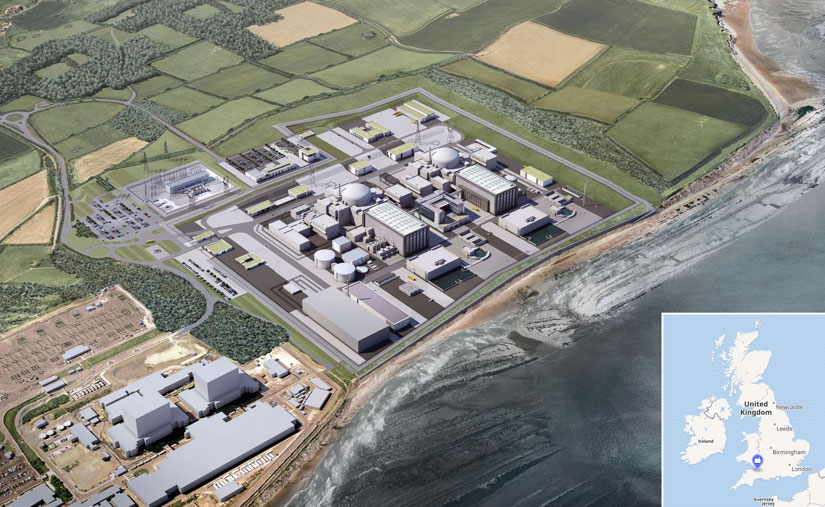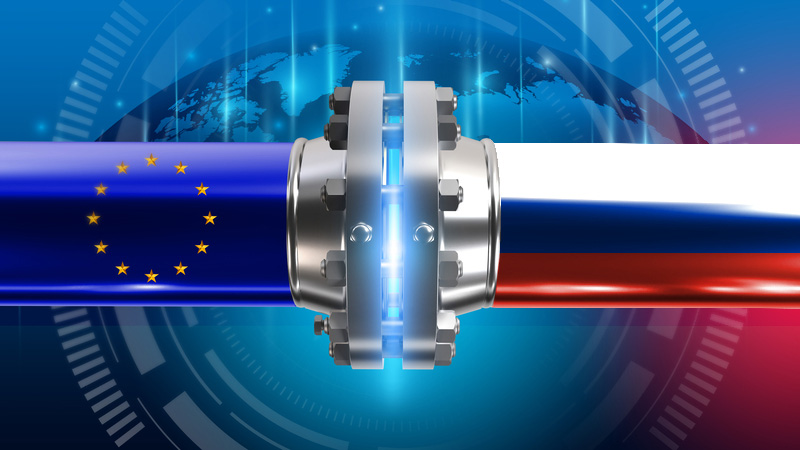
2027
The EU ends all energy imports from Russia
In February 2022, Russia began a full-scale invasion of Ukraine. This led to international condemnations and sanctions, millions of displaced Ukrainians, and the largest armed conflict in Europe since World War II.
The US and UK announced a ban on Russian oil, while the EU announced a two-thirds reduction in its demand for Russian gas. Oil companies Shell, BP, and ExxonMobil suspended all operations in the country. German Chancellor Olaf Scholz, previously in favour of the newly completed Nordstream 2 gas pipeline between Russia and Germany, suspended certification of the project indefinitely.
Amid soaring energy prices, Russia’s continued aggression against its neighbour, and longer-term concerns over climate change impacts, the EU proposed to go even further than its earlier announcement. The bloc’s leaders began drafting a plan to end their reliance on all Russian energy sources by 2027. Finalised in May, the REPowerEU project* would completely phase out Russian gas, oil, and coal imports, while accelerating the green transition.
Until this point, Russian fossil fuels had been used as an economic and political weapon, costing the EU nearly €100 billion per year. The bloc depended on Russia for about 40% of its gas, 27% of its oil, and 46% of its coal imports. The REPowerEU plan included measures to boost energy savings, diversify energy supplies, and accelerate the roll-out of renewable energy – all of which could strengthen economic growth, security, and climate action for Europe and its partners.
The energy saving aspect included raising the Energy Efficiency Target for the European Green Deal (a set of policy initiatives by the European Commission approved in 2020), from 9% to 13%. Fiscal measures included reduced VAT rates on energy efficient heating systems, building insulation, and appliances.
The energy diversification aspect would ensure the EU worked with reliable and trusted international partners to minimise supply disruptions. In addition to new gas pipeline deliveries and LNG imports, this included major developments with hydrogen, continuing beyond 2027.
Finally, and most notably, the REPowerEU project called for a massive scaling-up of renewables. It proposed a doubling of solar capacity by 2025 and a further 600GW by 2030, a legal obligation to install solar panels on all new buildings, a doubling of the rate of deployment of heat pumps and measures to boost both geothermal and solar thermal, shortened and simplified approvals for major renewable projects, and a target of 10 million tons of domestic hydrogen production for use in hard-to-decarbonise industries and transport sectors.
By 2027, the EU has invested €210 billion ($225 billion) in upgrading its energy infrastructure, allowing it to completely end any dependence on Russia for imports of oil, gas, and coal.*

EU/Russia 2027 – Illustration 247886273 © Leestat | Dreamstime.com
India becomes the most populous country
India is now overtaking China to become the most populous country in the world, home to nearly 1.5 billion people.* The gap between these two countries will begin to widen as China peaks and declines, while India continues to soar ahead for the next three decades before itself peaking in the late 2050s.
India’s gross domestic product (GDP) is growing rapidly during this time. Between 2020 and 2040, its share of world GDP almost doubles from 3.1% to 6.1% and it overtakes Japan to become the third largest economy.*
A major driver of India’s prosperity is the rapid expansion of its energy sector. Huge rural areas are undergoing electrification, with solar playing a key role – cheaper and more efficient than ever before and now challenging the dominance of coal. With its plentiful sunlight, India is geographically well placed to capture this energy source.
India’s population is also young, with 600 million people under the age of 25. India now rivals China for the most college graduates, the most cell phone and Internet users, and the largest middle class. It also remains the world’s largest democracy.
However, India faces serious governance, societal, environmental, and defence challenges that limit its ability to project a more assertive global foreign policy. While China and the United States compete, India is carving out a more independent role.
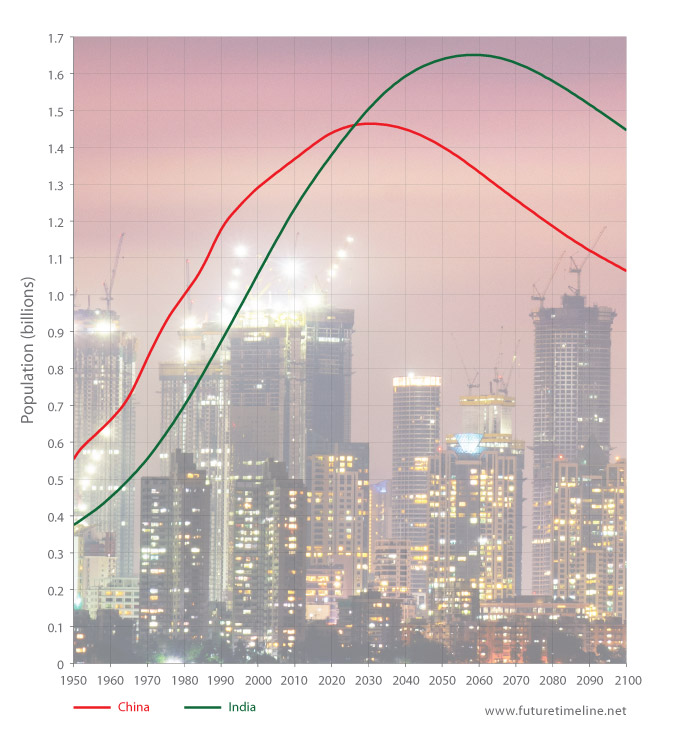
The BRICs
overtake the G7
By this date, the major emerging markets – Brazil, Russia, India and China, a.k.a. the BRICs – have overtaken the combined GDP of the G7 nations.*
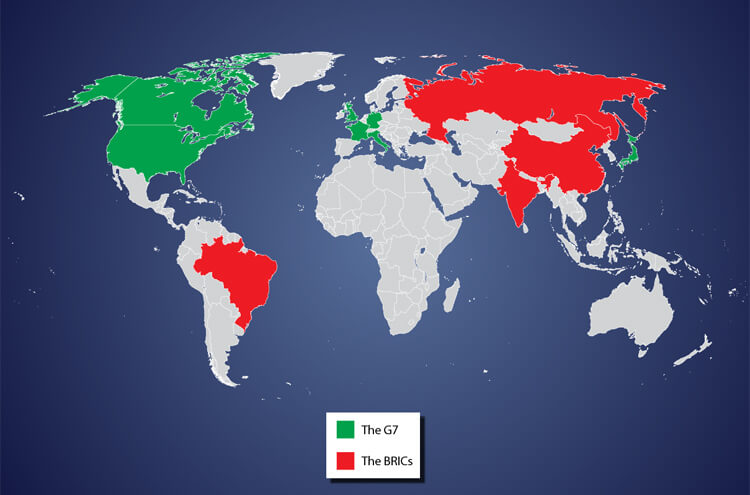
Light-duty hydrogen fuel cell vehicles reach 1 million in annual sales
The first vehicles powered by hydrogen fuel cells emerged during the Cold War Space Race. These were bulky, inefficient and expensive, however. It was not until the dawn of the 21st century that car manufacturers began to take the concept more seriously.
In 2003, President George Bush proposed the Hydrogen Fuel Initiative (HFI), which was later implemented by legislation through the 2005 Energy Policy Act and the 2006 Advanced Energy Initiative. This aimed to further develop hydrogen fuel cells and infrastructure with the goal of producing commercial fuel cell vehicles. By 2008, over $1 billion had been contributed to the project.
However, the U.S. Department of Energy later shifted its interest from fuel cells to battery vehicles. High costs and the lack of infrastructure were major problems, compounded by the challenge of deploying fuel stations over such a large geographical area. This led U.S. automakers to delay their hydrogen vehicle rollouts. The situation was different in Europe, however – with less geography to cover – and where governments had serious plans to develop the required infrastructure.* Japan and South Korea, too, had similar initiatives getting underway.
In addition to expanded infrastructure, further advances in technology reduced the size, weight and cost of hydrogen fuel cell vehicles.* By 2027, global sales of these non-polluting vehicles have reached one million annually for the first time.* Although still only a tiny proportion of total, overall vehicle sales, the industry is now entering a period of explosive growth.*
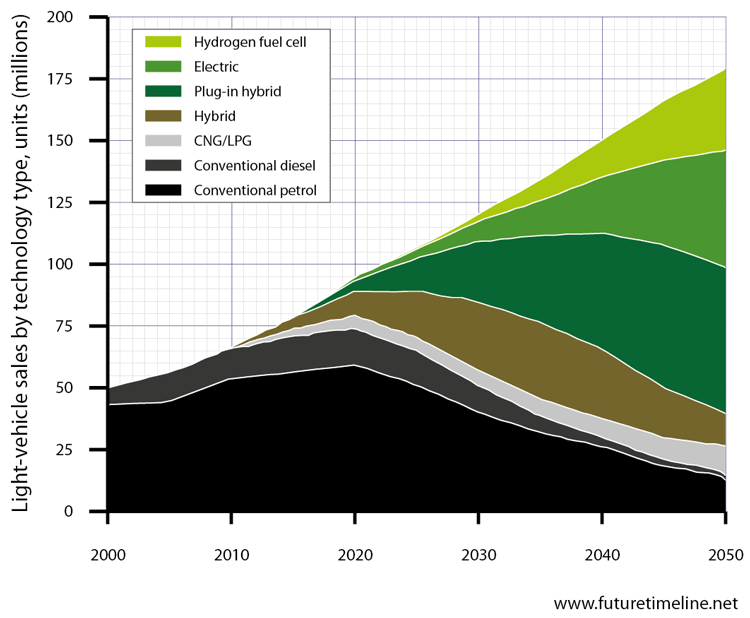
Tokyo and Nagoya are connected by high-speed maglev
Two of Japan’s largest cities – Tokyo and Nagoya – are now connected by the Chūō Shinkansen – a high speed maglev route. This 178 mile (286 km) line runs beneath the Japanese Alps (Akaishi Mountains), at speeds of up to 313 mph (505 km/h), enabling journey times of just 40 minutes. Built by the Central Japan Railway Company, at a cost of 9 trillion yen ($115bn), the route will be extended to Osaka by 2045.**
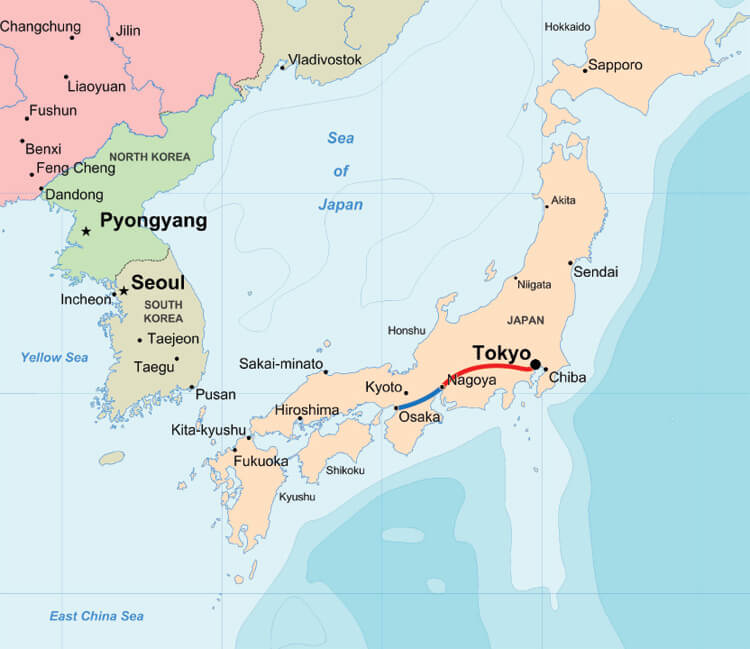
Carbon
sequestration is underway in many nations
Following
years of research and development, various new techniquess
are now being utilised for trapping and removing CO2. This is offering
fresh hope for mitigating the effects of climate change. The most
significant technology is “clean coal”, being fitted to power
plants. This is seeing widespread adoption, since it now costs less
than unsequestered coal-based power generation.* The carbon dioxide is stored in geological formations deep underground
(including some empty oil wells). Great care and precision must be taken
in choosing these sites, however, as dumping the gas in an unstable
location may cause it to leak back up to the surface or contaminate
aquifers used for drinking supplies.
Another
method of carbon sequestration which is showing great potential is the
deployment of “artificial trees”. These are shaped like giant
fly swatters around 10m high, and have become an increasingly common
sight along roads, freeways and other polluted areas.* The trees capture CO2 through a filter system – thousands of times more efficiently
than real trees – which is then removed and stored.
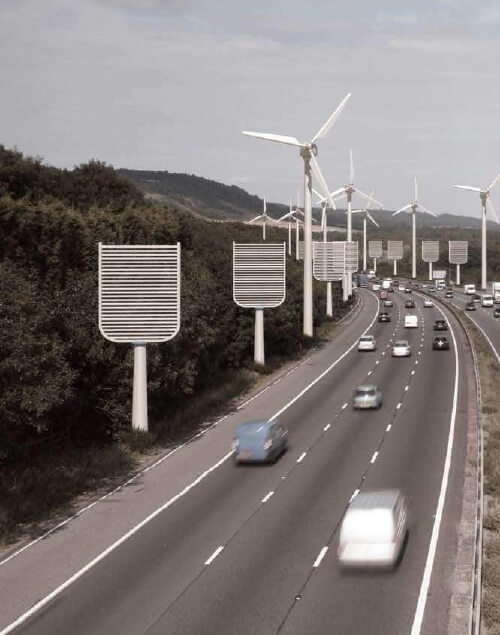
Credit: Institution
of Mechanical Engineers
Another project involves strips of algae, fitted to the sides
of buildings, which naturally absorb CO2 through photosynthesis. They
are most common in high-density urban centres, where tall buildings
offer a much greater surface area. These “photobioreactors” not only sequest carbon, but can also produce biofuel
and biochar as beneficial side effects. The biofuel can be used to generate
energy whilst keeping net carbon emissions to zero, while the biochar
can be used as a very good fertiliser.*
Yet another
project is the addition of highly reflective panels on rooftops. These
reflect sunlight back into space, reducing the amount of solar radiation
being absorbed by the Earth.
Although
efficient, the various techniques described above (and others) do not represent the ultimate solution to global warming. The
only effective, long-term process for stabilising the climate is the
adoption of solar, wind, hydro, nuclear and other renewable energy sources.
Thankfully,
almost all developed countries now have legally-binding commitments in place
for reducing CO2 emissions and have begun large-scale practical measures.
Britain, for example, has cut its carbon dioxide pollution by 50% compared
to 1990 levels, thanks to legislation enacted in 2011.*
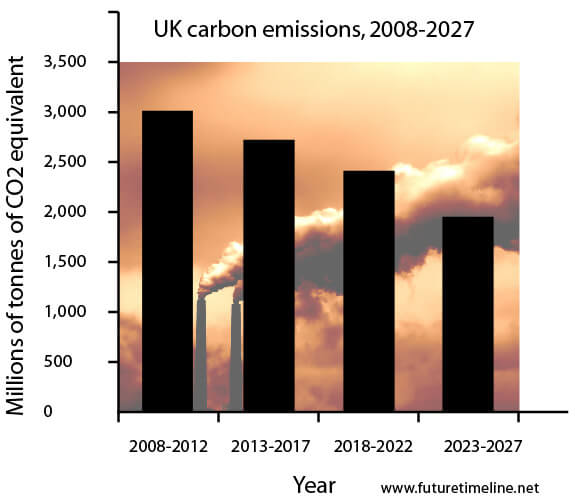
The Starlab commercial space station is operational
Starlab is the first ever free-flying commercial space station. Announced in October 2021, the project is a collaboration between Nanoracks, Voyager Space and Lockheed Martin.*
It features 340m³ of internal volume, about one-third that of the International Space Station (ISS). As a continuously crewed platform, it ensures a continued U.S. presence in low-Earth orbit, at a time when the ISS is nearing the end of its lifespan.
The basic elements of the Starlab space station include a large inflatable habitat, designed and built by Lockheed Martin, a metallic docking node, a power and propulsion element (60kW), a large robotic arm for servicing cargo (maximum payloads of 22m³), and a state-of-the-art laboratory system with comprehensive research, science, and manufacturing capabilities. Among the services provided are materials research, plant growth and other biotech, astronaut missions and space tourism. It can hold up to four passengers at any one time.
Initial operational capability begins in 2027. There are now several space stations in Earth or near-Earth orbit – Starlab, the soon-to-be-retired ISS, China’s new space station, and the under-construction Lunar Gateway.
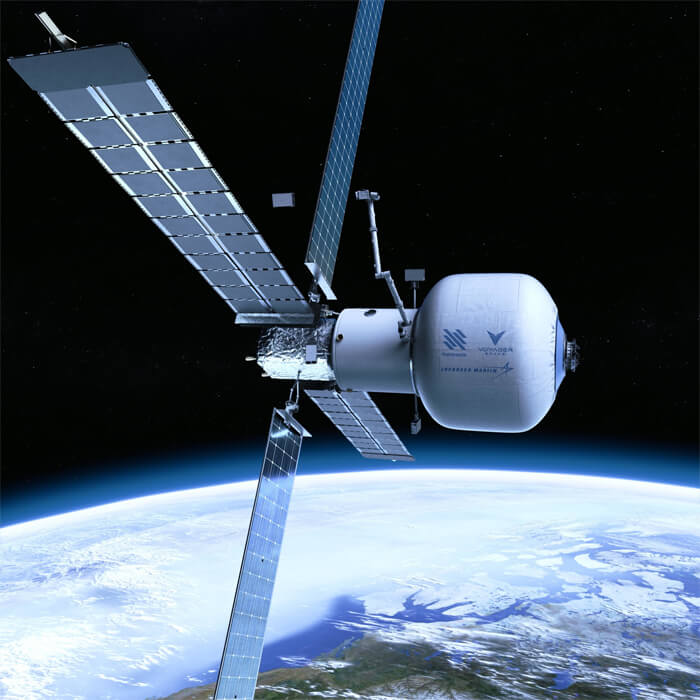
The Venera-D mission arrives at Venus
Venera-D is a Russian space probe sent to study the atmosphere and surface of Venus. The primary aim of the mission is to understand the history and evolution of the planet. Venera-D was first proposed to the Russian Academy of Sciences in 2003, with a planned launch date of 2013. The original design featured a large orbiter, sub-satellite, two balloons, two small landers and one larger, longer-lived lander. However, it was scaled down and delayed until the late 2020s. The final configuration would have two components: one orbiter and one lander.
The spacecraft is launched in 2026, arriving in 2027.* The orbiter includes several spectrometers, a plasma package and camera. Its radar remote-sensing equipment is far more powerful than the Venera 15 and 16 probes of the 1980s and the NASA Magellan in the 1990s. A wealth of new data is gathered to more accurately characterise the composition of the atmosphere, clouds and their structure, radiative balance and the nature of the greenhouse effect, ionosphere, magnetosphere and electrical activity, along with the gas escape rate in the upper atmosphere. This reveals new insights into the early history of Venus and the oceans of water it held in the ancient past.* Knowledge is also gained about the nature of “super-rotation” – a phenomenon in which the atmosphere circles the planet in just four Earth days, far faster than the sidereal day of 243 days – but decreases at lower altitudes, so that wind speeds barely reach 10 km/h (6 mph) on the surface.
In addition to the orbiter is a lander, which investigates one of the planet’s tesserae. These are regions of very old, heavily deformed terrain characterised by intersecting tectonic elements, high topography and high radar backscatter. This becomes the first probe to successfully touch down on Venus’s surface since the Soviet Union’s Vega 2 mission, 42 years earlier in 1985. It features a high-resolution camera to obtain panoramic images of both its descent through the atmosphere and the surroundings at ground level. The lander investigates the structure and chemical composition of the atmosphere and performs chemical analysis of surface materials. The interaction between the surface and the atmosphere is studied. The lander also characterises the geology of local landforms at different scales.
Due to the hellish conditions on Venus (temperatures of 462 °C, atmospheric pressure 92 times that of Earth, and clouds of sulphuric acid), the lander was originally expected to last for only one or two hours. However, with new materials and more robust electronic systems, it is redesigned to survive longer than any previous mission. This is helped in part by a collaboration with NASA, who supply a number of components.*
Venera-D is the first in a new generation of Russian probes to Venus. The mapping data obtained by the orbiter is used to determine the location of potential future landing sites. These follow-up missions also include sensors designed to search for signs of life in the mid-level atmosphere, which is seen as a possible habitat for extremophile organisms.*
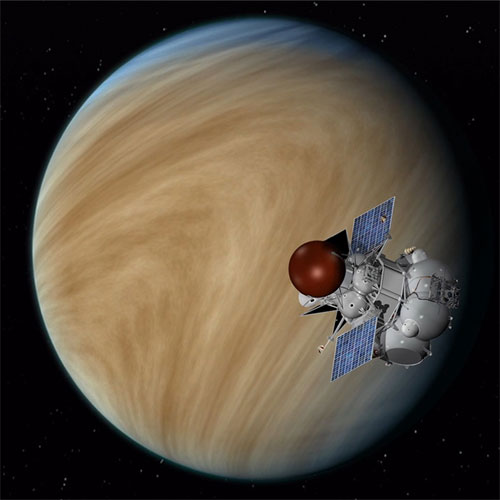
Credit: NASA/JPL-Caltech
The asteroid 1999 AN10 makes a close approach
1999 AN10 is an asteroid of the Apollo group, a collection of Earth-crossing bodies, many of which are large enough and can drift close enough to Earth to be considered potentially hazardous. It was discovered by U.S. scientists on 13th January 1999. The object was estimated to have a diameter of up to 1,800 m (5,905 ft), or about a mile – enough to cause continent-scale devastation, should an impact occur on Earth.
AN10 circles the Sun every 643 days and twice each year passes through the Earth’s local neighbourhood. On 7th August 2027,* it makes a particularly close approach as it comes within just 0.0026 AU (390,000 km; 240,000 mi), about the same as the distance between the Earth and Moon. The asteroid reaches a peak apparent magnitude of 7.3, bright enough to be visible in binoculars. Its orbit remains dangerously close for the next 600 years.*

The Square Kilometre Array begins science operations
Humanity’s
view of the universe is greatly expanded with the completion of a major
new observatory. The Square Kilometre Array (SKA) is a radio telescope
with a combined collecting area of approximately one kilometre. It operates
over a wide range of frequencies and its size makes it 50 times more
sensitive than any other comparable instrument. By utilising
advanced processing technology, it can survey the sky more than 10,000
times faster than ever before. With additional stations extending to a distance
of 3,000 km from a concentrated central core, it continues radio astronomy’s
tradition of providing the highest resolution images in all of astronomy. First light is achieved in 2027* and the telescope is fully operational by 2030.
Click
to enlarge

Image used with permission from Jo Bowler, SKA Program
Development Office, Jodrell Bank Centre for Astrophysics.
New Zealand’s first “smoke-free” generation
In 2021, the New Zealand government announced measures to crackdown on the tobacco industry. About 12% of people aged 15 or older smoked, a figure that rose to almost 30% for indigenous Māori adults. Although smoking had declined, without action it would be decades before rates fell below 5%. Cigarette smoke killed 5,000 people a year in New Zealand, making it one of the country’s top causes of preventable death. Four in five smokers started before the age of 18 and two-thirds of smokers would die prematurely as a result of their habit.
The government consulted with a Māori health task force, before introducing legislation into parliament, which became law by the end of 2022. The plan would be rolled out in stages, beginning with a reduction in the number of authorised sellers in 2024, followed by reduced nicotine (the most addictive ingredient) in 2025 and then the creation of the first “smoke-free” generation from 2027.
This law progressively lifts the minimum age for tobacco purchase, by a year every year, starting with 18-year-olds. In other words, it prevents anyone younger than the minimum from ever buying tobacco during their lifetime. For example, a person who turns 42 in 2050 will be banned from buying cigarettes, while a person aged 43 or older is allowed to do so.*
While concerns arise over criminal traders selling illegal products, the overall effect is a largely smoke-free generation emerging in New Zealand for the first time. In addition to improved health and life expectancy, this eventually provides economic benefits of more than NZD$2.5 billion or about 1.2% of the country’s GDP.

Credit: Anton Watman
The autopsy report for Elvis Presley is made public
Elvis Presley was one of the 20th century’s most iconic singers, often referred to as the “King of Rock and Roll”, or simply “the King”. After cementing his place among the legends of American music, his final years were marked by serious health problems. These were aggravated, and possibly caused by, drug dependence. On 16th August 1977, Presley was found unresponsive on the bathroom floor of his Graceland home. Attempts to revive him failed, and death was officially pronounced at 3:30pm at Baptist Memorial Hospital, Tennessee.
Controversy surrounded the autopsy and its aftermath as the competence and ethics of two medical professionals were questioned. One had his licence permanently revoked, after charges were brought by the Tennessee Medical Board. An overdose of prescription drugs (including codeine, Demorol, morphine and Valium, to name a few) had apparently caused Elvis’ heart to beat irregularly and then stop. However, rumours of a cover-up were rife as the exact cause of death remained unclear. Vernon Presley, Elvis’ father, had the complete autopsy report sealed for a period of 50 years.
The controversy surrounding the autopsy – as well as various other questionable circumstances – led conspiracy theorists to proclaim that the King was still alive. After his funeral, there were numerous alleged sightings of Presley. A long-standing theory among fans was that he had faked his own death. Some fans noted apparent discrepancies in the death certificate, a curious different spelling of the middle name on his gravestone, him reportedly cutting family members out of his will shortly before he died, rumours of a wax dummy in his original coffin and numerous accounts of Presley planning a diversion so he could retire in peace.
The full autopsy report is finally made public on 16th August 2027, exactly half a century after Presley’s death.*

Opening of the New Central Polish Airport
The New Central Polish Airport (also known as “Solidarity Transport Hub”) is a megaproject to construct a new, built-from-scratch airport located 40 km southwest of Warsaw, Poland. This replaces the aging and overcrowded Warsaw Chopin Airport.
Initially opening with two runways and a capacity of 45 million passengers per year, a substantial upgrade occurs in subsequent years – boosting its capacity to around 100 million, with four runways. Alongside a major expansion of the surrounding rail network, this forms the largest transportation hub in central and Eastern Europe, serving as a gateway to and from Asia. In terms of total passenger numbers, it eventually rivals some of the busiest airports in the world, including the likes of Hartsfield–Jackson in Atlanta, Beijing Capital International Airport, and Dubai International Airport.
More than 100 Polish cities throughout the country receive a direct rail link to the new airport, allowing for connections to the airport-rail hub from the most important urban centres in Poland. This includes high-speed routes, with trains running at 250 km/h (155 mph) on some sections.
The project faces considerable opposition from local residents, as well as concerns over its financial viability, but is approved by the government. A series of design concepts by world-leading architects emerged in 2019, with a winning candidate selected in 2020.* Costing 35 billion złoty ($9.4 billion), the initial phase completes construction by 2027.*
Other airports in Europe are undergoing major expansions in this decade, as global demand for air travel continues to increase. For example, a third runway opens at Heathrow Airport, London, in 2029. The New Central Polish Airport allows Poland to compete with western European countries on the aviation market and establish a greater share of international traffic. This generates an extra $7 billion in annual GDP and 65,000 new Polish jobs by 2035.

Completion of the Australia–ASEAN Power Link
The Australia–ASEAN Power Link (AAPL) is a clean energy megaproject that includes the world’s largest solar plant, the world’s largest battery, and the world’s longest submarine power cable.
The solar photovoltaic (PV) plant is located near Elliott in Australia’s Northern Territory. The PV modules cover 12,000 hectares (30,000 acres) in a region with some of the best sunlight in the world, which enables a generating capacity of 10,000 MW. For comparison, the largest operating solar farm in 2020, the Bhadla Solar Park in northwest India, had a nameplate capacity just 22.4% as high. With a total area of 120 km², the AAPL is large enough to be visible from space.
Running north from the AAPL is a high-voltage, direct current (HVDC) transmission line, which delivers electricity for export to southeast Asia. This passes through Darwin on Australia’s north coast, before continuing as an undersea power cable, stretching a total of 4,500 km (2,800 mi). Most of the exported power is supplied to Singapore, enough to provide 20% of the city’s total electricity. Batteries in both Darwin and Singapore produce load-balancing of 30GWh to account for variability in sunlight and energy demand, ensuring a continuous supply.
Developed by Sun Cable, a Singaporean firm founded in 2018, the total cost of the AAPL is S$22 billion (US$16.5 billion). Construction begins in mid-2023 with operations starting in early 2026 and full completion by late 2027.**
With its sheer size, capacity, and cable length, the AAPL forms the major backbone of a continent-wide supergrid that emerges in Australasia and Oceania during the mid-21st century. Further into the future, this vast electrical infrastructure is boosted even more, by the addition of room-temperature superconductors that provide lossless transmission.*
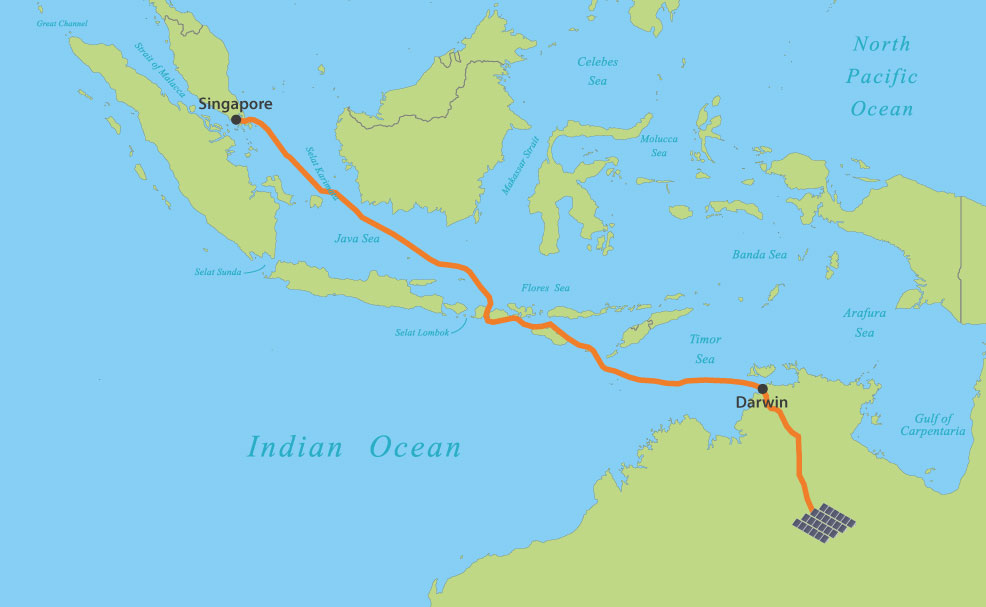
The Hinkley Point C nuclear power station is operational
The UK’s first commercial nuclear reactor began operating in 1956 and, at the peak in 1997, 26% of the nation’s electricity came from nuclear power. In the early 21st century, however, many of these aging reactors were being retired and the share had declined to 19% by 2012. Of the remaining nine plants – with a combined capacity of 9,000 MW – eight were due for closure by the early 2020s. Not only that, but coal power stations needed replacing too. The UK faced the prospect of losing two-thirds of its electricity by 2030 without major investment to improve its energy infrastructure.
In 2011, the government announced plans for a new fleet of nuclear power stations. All would be constructed at or near the existing nuclear power sites to minimise disruption. The first of these was Hinkley Point C, proposed next to Hinkley A and B, two older stations. This was approved in 2013, with construction starting in 2018. Two new reactors would be installed with a combined capacity of 3,200 MW – enough to supply an area twice the size of London, accounting for nearly 10% of the UK’s electricity demand.
The project – funded by a consortium of French and Chinese investors, including EDF Group – came under heavy criticism for its high costs, especially when compared to the latest solar PV and wind farms. Initially expected to be £14bn ($19.3bn), this had mushroomed to £26bn ($32.8bn) by 2022. EDF had agreed a price of £92.50 per megawatt hour (MWh) for electricity produced at Hinkley Point C. However offshore wind developers building the latest turbine arrays in waters off the UK’s coast were already offering less than £40/MWh.
Hinkley Point C also faced considerable delays in construction. Originally planned for connection to the national grid by 2017, the developers pushed this schedule back again and again. The facility is finally operational by 2027,* the first new fission power plant in the UK since 1995. It has an operational lifetime of 60 years.
